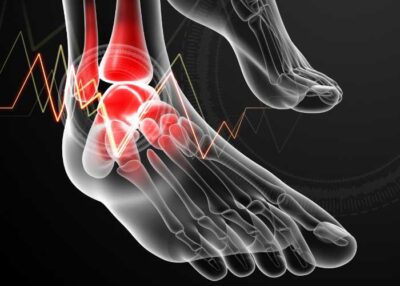Osteochondral Injuries Specialists
Adolescents and young adults can be prone to a specific type of ankle injury which can lead to ankle can lead to an osteochondral lesion, sometimes called osteochondritis dissecans (OCD). These types of injuries involve the bone and the cartilage of the ankle and are characterized by small pieces of bone breaking off inside the joint. OCD of the ankle and other osteochondral injuries can cause joint stiffness, pain and decreased mobility. Osteochondral lesion specialists Doctors Thomas Haytmanek and Jonathon Backus have diagnosed and treated many patients in Vail, Aspen, and the surrounding Denver, Colorado communities who have experienced symptoms associated with OCD of the ankle. Contact The Steadman Clinic’s Sports Foot and Ankle team today!

What is an osteochondral injury in the ankle?
Many types of injuries to the ankle can lead to an osteochondral lesion, sometimes called osteochondritis dissecans (OCD). This is an injury that affects the smooth surface at the end of bones, which is made of articular cartilage. It affects both the cartilage (chondro) and the bone (osteo) underneath and most often occurs in the ankle, knee or elbow. Adolescents and young adults are more prone to this type of injury which varies from small fractures or softening of the bone (and the cartilage that covers it) to pieces of the bone and cartilage breaking off inside the joint. The pieces of bone that may break can vary in size and can also stay attached to the injured site without necessarily becoming loose inside the joint. An osteochondral injury can stem from a few causes: in younger individuals, the lesion is believed to stem from improper blood flow to the affected bone. Other causes include repetitive strain or traumatic injury. The Steadman Clinic’s Sports Foot and Ankle specialists have extensive training and experience in treating OCD and can help patients in Vail, Colorado and the surrounding Eagle and Vail Mountain ranges.

What are the symptoms of osteochondral injury or osteochondritis dissecans (OCD)?
Symptoms can include:
- Decreased mobility in the affected area
- Limited range of motion
- Instability of the joint
- Pain when weight is applied
- Swelling or tenderness worsened by activity or playing sports
- Catching or locking sensation in the joint
How is an osteochondral injury or osteochondritis dissecans (OCD) diagnosed?
Our specialists will perform a physical examination of the joint for stability and range of motion. They will order an x-ray to view the affected bones and give an initial OCD diagnosis. An MRI or CT scan can provide our specialists with images of damaged cartilage and will help them determine the severity of OCD. They will then explain the best treatment options available.
What is the treatment for an osteochondral injury or osteochondritis dissecans (OCD)?
Non-Surgical Treatment:
A non-surgical approach is usually geared toward children and adolescents who are skeletally immature. It is possible for young children to heal an OCD as their bones develop more fully. Children tend to respond better than an older population to a period of immobilization. An average recovery is two to four months. Bracing the injury may alleviate pain, but in adults surgery may be required. Other non-surgical treatments include PRICE (protection, rest, ice, compression, elevation), NSAIDs, such as ibuprofen, certain exercises and physical therapy to improve flexibility and strength.
Surgical Treatment:
Surgery may be required if non-surgical methods do not improve pain and swelling due to an osteochondral lesion. If surgery is necessary, due to the lesion’s separation from the surrounding bone and cartilage, the loose portion of the bone and cartilage will be removed and/or repaired. Surgery may also be required for large lesions measuring one centimeter in diameter or greater. Our Doctors typically prescribe a period of non-weight bearing after surgery. This limits stress on the repair site for a certain period of time and promotes healing. The patient may need crutches for about six weeks to avoid bearing weight on the injured ankle. Physical therapy and strength training for about six weeks will need to be completed to ensure proper recovery. The patient may return to athletics after a four-to-six-month period of time.
For more information on osteochondral injuries, please contact the office of Drs. C. Thomas Haytmanek and Jonathon Backus, Orthopedic Foot and Ankle Specialists serving Vail, Colorado and the surrounding Eagle, Vail Mountain Range Community.